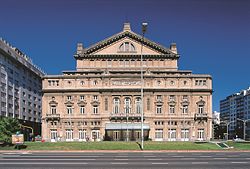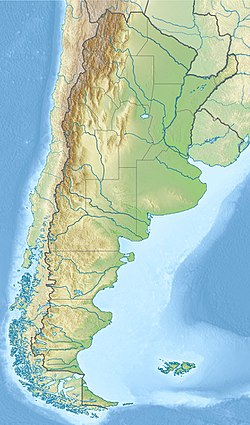
Back Буенос-Аирес Abkhazian Buenos Aires ACE Буэнос Айрес ADY Buenos Aires Afrikaans Buenos Aires ALS ብዌኖስ አይሬስ Amharic Buenos Aires AN Buenos Aires ANG بوينس آيرس Arabic بوينوس آيريس ARY
Buenos Aires | |
|---|---|
| Autonomous City of Buenos Aires Ciudad Autónoma de Buenos Aires | |
| Nicknames: | |
| Coordinates: 34°36′13″S 58°22′53″W / 34.60361°S 58.38139°W | |
| Country | |
| Established |
|
| Districts | 15 |
| Government | |
| • Type | Autonomous city |
| • Body | City Legislature |
| • Chief of Government | Jorge Macri (PRO) |
| • Deputy Chief of Government | Clara Muzzio |
| • National Deputies | 25 |
| • National Senators | |
| Area | |
• Capital city and autonomous city | 205.9 km2 (79.5 sq mi) |
| • Urban | 3,979.2 km2 (1,536.4 sq mi) |
| • Metro | 13,267 km2 (5,122 sq mi) |
| Elevation | 25 m (82 ft) |
| Population (2022 census)[5] | |
• Capital city and autonomous city | 3,121,707 |
| • Rank | 1st in Argentina 7th in South America |
| • Density | 15,161/km2 (39,270/sq mi) |
| • Urban | 13,971,006 |
| • Urban density | 3,511/km2 (9,090/sq mi) |
| • Metro | 16,366,641 |
| • Metro density | 1,234/km2 (3,200/sq mi) |
| Demonyms | porteño (m), porteña (f) |
| GDP | |
| • Capital city and autonomous city | US$ 35 billion[8] |
| • Metro | US$ 236 billion[8] |
| Time zone | UTC−03:00 (ART) |
| Postal codes | B1601XXX to B8512XXX[9] |
| Area code | 011 |
| ISO 3166 code | AR-B[10] |
| HDI (2021) | 0.882 very high (1st)[11] |
| Website | buenosaires.gob.ar |
Buenos Aires,[d] controlled by the government of Autonomous City of Buenos Aires,[e] is the capital and largest city of Argentina. It is located on the southwest of the Río de la Plata. Buenos Aires is classified as an Alpha− global city, according to the Globalization and World Cities Research Network (GaWC) 2024 ranking.[14] The city proper has a population of 3.1 million and its urban area 16.7 million, making it the twentieth largest metropolitan area in the world.[15]
The city of Buenos Aires is neither part of Buenos Aires Province nor its capital; it is an autonomous district. In 1880, after the Argentine Civil War, Buenos Aires was federalized and split from Buenos Aires Province.[16] The city limits were enlarged to include the towns of Belgrano and Flores; both now neighborhoods of the city. The 1994 constitutional amendment granted the city autonomy, hence its formal name of Autonomous City of Buenos Aires. Thus, citizens elected their first Chief of Government in 1996; previously, the Mayor was directly appointed by the President of Argentina.
The Greater Buenos Aires conurbation includes several surrounding cities, which are located in the neighbouring districts of the Buenos Aires Province. It constitutes the fourth-most populous metropolitan area in the Americas.[15] It is also the second largest city south of the Tropic of Capricorn. Buenos Aires has the highest human development of all Argentine administrative divisions[17] and its quality of life was ranked 91st in the world in 2018, being one of the best in Latin America.[18][19]
It is known for its preserved eclectic European architecture[20] and rich cultural life.[21] It is a multicultural city that is home to multiple ethnic and religious groups, contributing to its culture as well as to the dialect spoken in the city and in some other parts of the country. This is because since the 19th century, the city, and the country in general, has been a major recipient of millions of immigrants from all over the world, making it a melting pot where several ethnic groups live together. Thus, Buenos Aires is considered one of the most diverse cities of the Americas.[22]
- ^ "5 cosas que tienes que ver en Buenos aires". 7 March 2016. Archived from the original on 27 December 2018. Retrieved 9 November 2023.
- ^ Corsalini, Claudio (4 February 2017). "En la 'Reina del Plata', sólo el 3% de las calles tiene nombre de mujer". Perfil (in Spanish). Archived from the original on 1 December 2017. Retrieved 25 November 2017.
- ^ Lewis, Colin M. (2002). Argentina: A Short History. Oxford: Oneworld Publications. ISBN 1-85168-300-3.
- ^ Green, Toby (4 February 2001). "The Paris of South America". The Independent. Archived from the original on 9 June 2020. Retrieved 9 June 2020.
- ^ a b c d "Cuadro 2. Total del país. Total de población, densidad y superficie - Ciudad Autónoma de Buenos Aires (205.9 km2) y 24 Partidos del Gran Buenos Aires (3,773.3 km2) [2022]". www.indec.gob.ar. INDEC. 21 November 2023. Retrieved 27 January 2025.
- ^ a b c "Región Metropolitana: Ciudad Autónoma de Buenos Aires y 39 partidos de la provincia de Buenos Aires (2022) [pg.7-10]" (PDF). www.indec.gob.ar. INDEC. September 2024. ISBN 978-950-896-676-6. Retrieved 27 January 2025.
- ^ "Mercado de trabajo. Tasas e indicadores socioeconómicos (EPH)" (PDF). INDEC. 18 December 2024. p. 17.
- ^ a b "TelluBase—Argentina Fact Sheet (Tellusant Public Service Series)" (PDF). Tellusant. Archived (PDF) from the original on 16 January 2024. Retrieved 11 January 2024.
- ^ "Buenos Aires Postal Codes". postalcodes.azinfoportal.com. Retrieved 27 February 2024.
- ^ "Argentina Country Codes". codesofcountry.com. Archived from the original on 3 July 2024. Retrieved 27 February 2024.
- ^ "El mapa del desarrollo humano en Argentina" (PDF). United Nations Development Programme. 25 June 2023. Archived (PDF) from the original on 11 June 2023. Retrieved 25 June 2023.
- ^ "Buenos Aires City". The American Heritage Dictionary of the English Language. Boston: Houghton Mifflin Harcourt. 2001. Archived from the original on 18 July 2011.
- ^ Wells, John C. (2008), Longman Pronunciation Dictionary (3rd ed.), Longman, ISBN 9781405881180
- ^ "World Cities 2024". GaWC – Research Network. Retrieved 29 January 2025.
- ^ a b "Demographia World Urban Areas, 18th Annual Edition" (PDF). Demographia. July 2022. Retrieved 30 January 2023.
- ^ Ruiz Moreno, Isidro (1986). La federalización de Buenos Aires: debates y documentos. Buenos Aires: Buenos Aires: Hyspamerica. ISBN 978-950-614-467-8.
{{cite book}}: CS1 maint: publisher location (link) - ^ "El mapa del desarrollo humano en Argentina" (PDF). United Nations Development Programme. 25 June 2023.
- ^ "Vienna tops Mercer's 20th Quality of Living ranking". Mercer. Archived from the original on 16 April 2018. Retrieved 15 April 2018.
- ^ "2018 Quality of Living City Rankings". Mercer. Archived from the original on 18 April 2018. Retrieved 15 April 2018.
- ^ "Introduction to architecture in Buenos Aires". Lonely Planet. 14 June 2011. Archived from the original on 18 January 2015. Retrieved 18 January 2015.
- ^ "Buenos Aires History and Culture". Adventure Life. Archived from the original on 16 September 2012. Retrieved 28 May 2012.
- ^ Buenos Aires Ciudad. "Turismo Religioso" (in Spanish). Archived from the original on 5 January 2016. Retrieved 25 November 2015.
Cite error: There are <ref group=lower-alpha> tags or {{efn}} templates on this page, but the references will not show without a {{reflist|group=lower-alpha}} template or {{notelist}} template (see the help page).
© MMXXIII Rich X Search. We shall prevail. All rights reserved. Rich X Search











